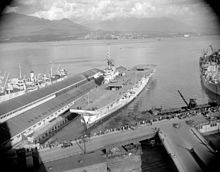Name HMS Warrior Commissioned 2 April 1945 Name HMCS Warrior Launched 20 May 1944 Draft 7 m Builder Harland and Wolff | Laid down 12 December 1942 Identification Pennant number R31 Construction started 12 December 1942 Length 212 m Beam 24 m | |
 | ||
Fate Transferred to the Royal Canadian Navy | ||
HMS Warrior was a Colossus-class light aircraft carrier which served in the Royal Canadian Navy from 1946 to 1948 (as HMCS Warrior), the Royal Navy from 1948 to 1958, and the Argentine Navy from 1959 to 1969 as ARA Independencia.
Contents
History
Built by Harland and Wolff in Belfast, she was originally to be called HMS Brave; the Royal Navy had originally intended to rush her into service for operations in the Indian Ocean during the Second World War, thus she was built without heaters for some onboard equipment since heat was unnecessary in tropical operations.
Royal Canadian Navy service
Acquisition
As the focus of future operations at sea during the Second World War shifted to the Pacific theatre, planning began in May 1944 that the Royal Canadian Navy (RCN) would require a larger fleet both in numbers and in size of ships. In the effort to get bigger, the RCN returned the escort carriers currently on loan, Puncher and Nabob in exchange for the loan of two light fleet carriers. The acquisition of two ships, Warrior and Magnificent, was completed in January 1945 with the option to purchase them outright at a later date. Negotiations were completed in May, however the war ended before the ships were completed.
Construction and service
Warrior was launched on 20 May 1944 and completed on 24 January 1946. She was loaned to the RCN, commissioned as HMCS Warrior and placed under the command of Captain Frank Houghton. She entered Halifax harbour on 31 March 1946, a week after leaving Portsmouth. She was escorted by the destroyer HMCS Micmac and the minesweeper HMCS Middlesex. Initially, Warrior was equipped with Seafires of 803 Squadron and Fireflies of 825 Squadron. The RCN experienced problems with the unheated equipment during operations in cold North Atlantic waters off eastern Canada during 1947. The ship was transferred west to Esquimalt in November 1947. The RCN deemed her unfit for service and, rather than retrofit her with equipment heaters and with reduced defence spending, the RCN could not afford two aircraft carriers. Warrior was then returned to the Royal Navy in exchange for Magnificent in February 1948.
Royal Navy service
HMCS Warrior returned to the United Kingdom and was recommissioned as HMS Warrior on 23 March 1948. Warrior was then refitted in Devonport and equipped with a flexible flight deck (layers of rubber) to test the feasibility of receiving undercarriage-less aircraft; the Sea Vampire was used to test the concept, which was successful but not introduced into service.
She went into reserve in September 1949, and was recommissioned in June 1950 as a transport for troops and aircraft to support British forces during the Korean War. The ship underwent refit during most of 1952 and 1953 at Devonport Dockyard. During 1954 Warrior was deployed to the Far East, patrolling off the coast of recently pacified Korea. In September the ship helped French and US Navy vessels evacuate non-Communist refugees from Haiphong, North Vietnam to Vung Tau, South Vietnam, transporting more than 3000 people in two voyages, and being awarded a South Vietnamese Presidential Citation. After returning to England another refit was carried out in 1955. This time Warrior received a very slightly angled flight deck for trials. She took part in Operation Grapple, the first British hydrogen bomb tests, embarking a handful of helicopters and Grumman Avenger AS.4s to collect samples from the tests and ferry them back for testing. After the operation was completed the Avengers were catapulted into the sea as they were contaminated with radioactivity. Considered surplus to requirements by the late 1950s, the Royal Navy decommissioned Warrior in February 1958 and offered her for sale. The return voyage from the Grapple tests was via Argentina, with port visits and demonstrations to the Argentine Navy, to whom the Admiralty was trying to sell her.
Argentine Navy service
She was sold to Argentina in 1958 and renamed ARA Independencia; Argentine Naval Aviation began air operations from her in June 1959, even before the vessel was officially commissioned into the fleet. The anti-aircraft armament was initially reduced to twelve 40 mm guns, soon further reduced to eight. In May 1962 the ship was however provided with one quadruple and nine double mountings of that caliber.
The air group was formed by F4U Corsair, SNJ-5Cs Texan and Grumman S2F-1 (S-2A) Trackers; Naval Aviation inventory also included F9F Panther (the first jet fighters in service with the Argentine Naval Aviation, starting from August 1963) and TF-9J Cougar jets, although Independencia proved to be unsuitable for operating them. They were only embarked during their delivery voyage from the United States to Argentina. The ship also used the North American T-28 Trojan trainer, in the armed version Fennec built in France.
After the carrier ARA Veinticinco de Mayo entered service in 1969, Independencia moved to the reserves (1970). She was scrapped in 1971.
